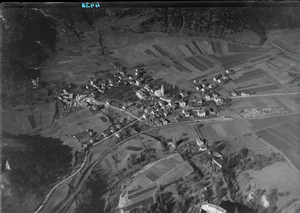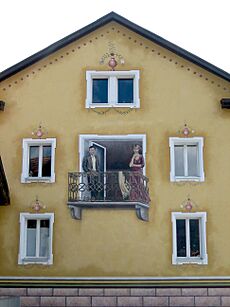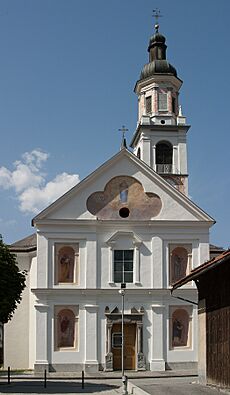Rhäzüns facts for kids
Quick facts for kids
Rhäzüns
|
||
|---|---|---|

Rhäzüns village
|
||
|
||
| Country | Switzerland | |
| Canton | Graubünden | |
| District | Imboden | |
| Area | ||
| • Total | 13.37 km2 (5.16 sq mi) | |
| Elevation | 657 m (2,156 ft) | |
| Population
(Dec 2020 )
|
||
| • Total | 1,611 | |
| • Density | 120.49/km2 (312.08/sq mi) | |
| Postal code |
7403
|
|
| Surrounded by | Bonaduz, Cazis, Domat/Ems, Präz, Rothenbrunnen, Versam | |
Rhäzüns is a small town, also called a municipality, in the Imboden Region of Grisons, a canton in Switzerland. Its name is pronounced "reh-TSYNS" in German and "rah-TSEN" in Romansh.
Contents
History of Rhäzüns
Rhäzüns was first mentioned in old writings around the year 840 AD. Back then, it was known as Raezunne.
For a long time, Rhäzüns and a nearby town called Bonaduz shared the same church area, known as a parish. This changed after the the Reformation, a big religious movement in Europe.
In 1424, Rhäzüns became part of the Grey League. This was a group of communities that joined together for protection. Later, in 1497, the powerful House of Habsburg took control of Rhäzüns. However, Rhäzüns still kept its legal rights within the Three Leagues, which was a larger alliance of communities.
During the time of Napoleon, in 1809, the Habsburg rulers gave Rhäzüns to France. But after Napoleon's defeat in 1814, it went back to the Habsburgs. Finally, in 1815, at a big meeting called the Vienna Congress, Rhäzüns was given to Grisons. Grisons then became a canton of the restored Swiss Confederacy. Rhäzüns officially joined Grisons on January 19, 1819.
Geography of Rhäzüns
Rhäzüns is located near the Hinterrhein River. This is just before it meets another river, the Vorderrhein.
The total area of Rhäzüns is about 13.3 square kilometers (about 5.1 square miles).
- Almost a quarter of this land (23.3%) is used for farming.
- Most of the area (69.1%) is covered by forests.
- A small part (4.2%) has buildings or roads.
- The rest (3.4%) includes rivers, glaciers, or mountains.
Before 2017, Rhäzüns was in a smaller area called the Rhäzüns sub-district. After 2017, it became part of the larger Imboden Region. The town itself is a "linear village," meaning its buildings are mostly spread out along a road in the valley. It sits between the towns of Bonaduz and the narrow entrance to the Domleschg valley.
People and Population in Rhäzüns
Rhäzüns has a population of about 1,600 people. As of 2008, about 15.4% of the people living in Rhäzüns were from other countries. Over the past ten years, the number of people living here has grown slowly, by about 0.3%.
In 2000, the population was almost evenly split between males and females. About 49.2% were male and 50.8% were female.
Here's a look at the age groups in Rhäzüns in 2000:
- 15.9% of the people were children aged 0 to 9 years old.
- 6.7% were 10 to 14 years old.
- 5.7% were 15 to 19 years old.
- 10.8% were young adults aged 20 to 29.
- 16.0% were 30 to 39 years old.
- 16.9% were 40 to 49 years old.
- 11.9% were 50 to 59 years old.
- 7.5% were 60 to 69 years old.
- 6.7% were 70 to 79 years old.
- 1.8% were 80 to 89 years old.
Politics and Education
In the 2007 Swiss federal election, the most popular political party in Rhäzüns was the SVP. They received 34.5% of the votes. Other popular parties included the CVP (23.2%), the SPS (21.9%), and the FDP (18.6%).
Many adults in Rhäzüns have a good education. About 74.8% of people aged 25-64 have finished either advanced high school or gone on to higher education, like a university.
Jobs and Economy
Rhäzüns has a low unemployment rate, which means most people who want to work can find jobs. In 2005:
- 27 people worked in the primary sector, which includes farming and forestry. There were 13 businesses in this area.
- 178 people worked in the secondary sector, which includes manufacturing and construction. There were 16 businesses in this area.
- 112 people worked in the tertiary sector, which includes services like shops and offices. There were 29 businesses in this sector.
Religion in Rhäzüns
According to the 2000 census, most people in Rhäzüns are Christian:
- About 61.7% of the population are Roman Catholic.
- About 23.3% belong to the Swiss Reformed Church.
- A small number of people belong to other Christian churches, including the Orthodox Church.
- About 5.25% of the population are Islamic.
- About 4.58% of the people do not belong to any church or are agnostic or atheist.
Historical Population Growth
The table below shows how the population of Rhäzüns has changed over time:
| year | population |
|---|---|
| 1850 | 508 |
| 1900 | 495 |
| 1950 | 774 |
| 1960 | 776 |
| 1970 | 903 |
| 1980 | 958 |
| 1990 | 1,018 |
| 2000 | 1,201 |
Languages Spoken in Rhäzüns
Most people in Rhäzüns speak German. As of 2000, about 79.4% spoke German. The second most common language is Romansh (10.1%), and the third is Italian (3.3%).
The table below shows how the number of speakers for each language has changed:
| Languages | Census 1980 | Census 1990 | Census 2000 | |||
|---|---|---|---|---|---|---|
| Number | Percent | Number | Percent | Number | Percent | |
| German | 486 | 50.73% | 736 | 72.30% | 953 | 79.35% |
| Romansh | 369 | 38.52% | 374 | 36.74% | 121 | 10.07% |
| Italian | 82 | 8.56% | 48 | 4.72% | 40 | 3.33% |
| Population | 958 | 100% | 1018 | 100% | 1201 | 100% |
Local Products
Rhäzüns is known for two special products:
- Its own brand of mineral water called Rhäzünser.
- A type of beer called Rhäzünser Pils.
Important Historical Sites
Rhäzüns is home to two very important historical sites. These are listed as Swiss heritage sites of national significance, meaning they are protected because of their historical and cultural value:
- The Baselgia S. Gieri/St. George's Church with its beautiful frescos (wall paintings).
- The Baselgia S. Paul/St. Paul's Church.
Transportation
The Rhaetian Railway provides train services to Rhäzüns (Rhaetian Railway station), making it easy to travel to and from the town.
See also
 In Spanish: Rhäzüns para niños
In Spanish: Rhäzüns para niños
















